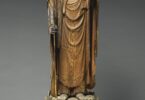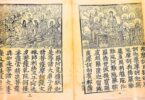What is the point of being ourselves [who are imperfect],
if we cannot recreate ourselves [to become perfect]?– Shilashanti
 Like other natural cycles such as the water cycle and the four seasons, the Buddha taught that the universe undergoes beginningless cyclical expansion and contraction, which is similar to the scientific model of the oscillating universe, that explains how the universe forms and ‘deforms’ through rounds of the Big Bang and Big Crunch.
Like other natural cycles such as the water cycle and the four seasons, the Buddha taught that the universe undergoes beginningless cyclical expansion and contraction, which is similar to the scientific model of the oscillating universe, that explains how the universe forms and ‘deforms’ through rounds of the Big Bang and Big Crunch.
The Abhassara gods are refined beings who attained their heavenly rebirths due to strong loving-kindness and/or meditative mastery of the second jhana. Due to the expiry of their limited heavenly karma, they ‘fell’ to the Earth, where probably moss-like vegetation developed on the seas. Giving rise to physical greed for it, their subtle mind-made forms became progressively material, coarse and complex.
The meeting of the first being with this food probably resembles how the primordial soup seems to be given a spark of sentient life. Though ‘equal’ in terms of realm of origin, with the individual proliferation of mental defilements, physiological differences due to gender, appearance and such arose, leading to discrimination.
When sexual attraction and coupling began, it led to the need for property and privacy. Vegetation devolved to be grosser and harder to harvest as an expression of the beings’ increasing negative karma from greed and desecration of nature. And due to rise in crimes, a monarchy was formed via democratic election for the best leader to mete out punishment and manage the masses. The king was seen as worthy because of his righteousness; not due to any ‘divine’ right. The salary to reward his service was voluntarily given, which evolved to be compulsory taxation. Since the Dharma (Truth and the path to it) is the best thing in the world, everything was done, measured, and valued upon it and not anything else.
As time passed by, a caste system developed, which later became rigid when its origins were forgotten. This corrupted system which artificially segregated people was the one the Buddha spoke against. However, all could abandon the caste imposed on them to become Ascetics (or monastics) to seek, practise and realise the Dharma – like the Buddha himself did.
The Agganna Sutta hints of some agreement with the Darwinian theory of evolution as it describes increasingly complex graduated changes in flora and fauna due to their cross-interaction over a long time. There is no first cause of life as rebirth occurs cyclically. The idea that ‘there must be a first cause’ of life which is another life form does not explain how this first life form originated, while ‘there must be a first cause’ of that life too. Science too does not detect spontaneous unconditioned generation of life.
Even evolution can be naturally cyclical, because beings can devolve too, as in the case of the fallen gods. Though the Buddha did not advocate creationism in the usual sense, there is ‘creationism’ in terms of how sentient beings can proactively (re)create their own destinies, thus (d)evolving physically and spiritually via their choice of thoughts, words and deeds. This can occur both on an individual or collective karmic level. In this sense, Buddhism can perhaps be seen to present a Middle Path between ‘evolution’ and ‘creationism’.
If beings can spontaneously come into being,
there is no need for a creator god.
If beings cannot spontaneously come into being,
there can be no creator god.– Shilashanti
Part 1:
Sutta Summary
https://thedailyenlightenment.com/2010/03/how-were-the-‘first’-humans-‘created’-part-1-sutta-summary
Related Articles:
How Can A ‘Creator’ Be ‘Created’?
https://thedailyenlightenment.com/2018/08/how-can-a-creator-be-created
Complete Agganna Sutta
http://www.urbandharma.org/pdf/AggannaSutta.pdf




